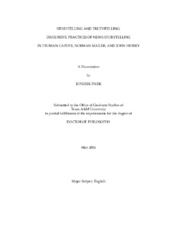| dc.description.abstract | Focusing on new-journalistic nonfiction novels by Truman Capote,
Norman Mailer, and John Hersey, this dissertation conceptualizes the
discursive practices of news-storytelling as a necessary matrix of storytelling
and truthtelling activities. Despite the dominant postmodern emphasis on
storytelling over truthtelling in such disciplines as literature, historiography,
journalism, and legal studies, storytelling-in-the-discipline is also constrained
by a set of assumptions and practices about what constitutes professional
storytelling.
Since news-stories report on events in a public arena where numerous
competing stories abound, they are highly aware of other neighboring stories
and so relate, compete, and negotiate with other stories to make their stories
not merely repetitive but argumentative and re-tellable. As a socially regulated
and conditioned discourse, news-storytelling in its enterprise is predicated upon different sets of discursive authorities, material conditions, and audience
expectations, where various facts and interpretations are argued, tested, and
judged.
Chapter I briefly surveys the ways in which news-storiesÂ’ claim to
referentiality is problematized and even stigmatized by the postmodern ethos
of storytelling. Chapter II then explores the discursive dynamics of newsstories,
which arise from the paradoxical status of being simultaneously news
and a story. Particularly, this chapter highlights the discursive practice of
“source marking” and “counter-storytelling” through which news-storytellers
foreground their reliability as able researchers, analysts, and contenders.
Chapter III discusses the issue of (inter-) textuality in the vectors of storyteller
and the world, and examines how news-storytellers draw on, blend into, and
counter competing and neighboring stories to situate their own stories in the
web of intertextuality and to reinforce the competency, honesty, and quality of
their news-stories. Chapter IV is a historical examination of a “transcript”
mode, a particular discursive practice of news-storytellers, through which they
try to uphold the empirical status of their news-stories. Chapter V concludes
the dissertation by arguing that news-stories provide a clarifying vantage point
from which to understand the transactions of historical discourse, where newsstorytelling
replaces (story) knowledge with argument, poetics with rhetoric,
and a story with a discourse. | en |


